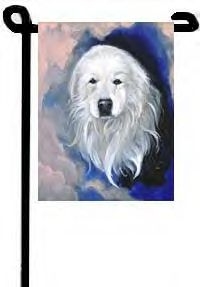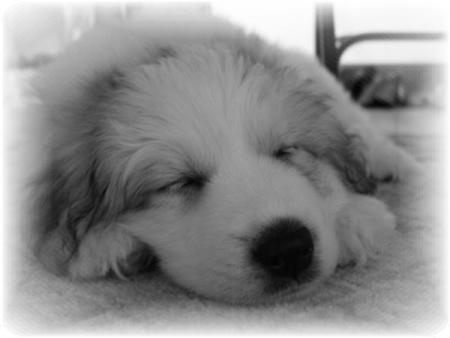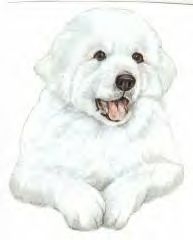|
~Send in reservation form to reserve in advance! They go fast.Visit our links!

Great
Pyrenees
(Pyrenean Mountain Dog) (Chien de Montagne
des Pyrénées)
The Great Pyrenees is also known as the Pyrenean Mountain Dog. Full grown this is a very
large animal with a solid muscular body. The long, coarse, outer coat is either straight or slightly wavy, while the fine
undercoat is soft and thick. The coat is weather resistant which allows it to live outdoors year round in very harsh climates.
Coat colors come in solid white, or white with patches of tan, wolf-gray or pale yellow. It has a black nose and dark brown,
almond-shaped eyes with a thoughtful, intelligent, dignified expression. The Great Pyrenees looks a lot like a brown bear
except for its light coloring. The body proportions are somewhat rectangular; the length is slightly more than the height
at the withers; the topline is level. The chest is fairly broad. The head is wedge-shaped with a slightly rounded skull with
no apparent stop. The medium-sized ears are triangular and pendant. The muzzle is wide and slightly pointed, and its lips
are not pendent. The teeth should ideally meet in a scissors bite, but level bite is allowed. The Great Pyrenees has single
dewclaws on the front legs and double dewclaws on the hind legs. The long, feathered, plumed tail curves upward slightly at
the tip and reaches at least to the hocks.
Livestock Guardian Dog (LGD) breeds
have been used for centuries to protect livestock from predators in Europe and Asia. The most well-known of these breeds in
the United States are the Great Pyrenees. Many also work as family and home guardians, and several are assistance dogs
to their disabled owners, as they are sturdy enough to provide physical support. With the right socialization, training and
physical environment, LGDs can be successful family pets and home protectors. They are generally aloof toward strangers and
their size alone is rather intimidating. Though strong, independent-minded and protective, they are normally gentle with children
and livestock alike. A common saying among LGD owners is "LGDs are like potato chips - you can't have just one".
The pyrenees are better suited as remote pasture guardians. They may work well on
a small farm, in a rural home, or as a city pet. Some may be found in the middle of New York City, others on the sprawling
rangelands of Montana.
They need daily exercise and the daily discipline of a job to do. This can be provided
on an open range, protecting livestock or in a suburban back yard, protecting a family. They have a long puppy-hood and adolescence,
often not reaching maturity until 2-1/2 or 3 years of age. During that time, they need training, supervision and a human who
is capable of assuming the "alpha" role in their pack.
First of all, not all Livestock Guardian Dogs (LGDs) are born in barns. Some are whelped
in the warmth and comfort of a home, (our litters are always whelped in our home) under the eyes of a concerned breeder. Their
place of birth is not as important as the circumstances under which they were bred.
Good LGD breeders are good observers: they spend enough time watching the pups in the
litter box, and later in the training pen, to know which pups are bold enough to be LGDs and which would rather sit on a lap
and be house dogs. While there are abbreviated “temperament tests”, they depend on a number of variables, and
can’t substitute for an experienced, observant breeder.
Livestock guardian dogs are becoming more and more popular all over the country. Socialization
and training to some degree is important for all LGDs It is only logical that dogs used on family farms or acreages
need to receive more human socialization and training than those used by ranchers in open range conditions. Even range-LGDs
must receive veterinary attention at least annually, and they must occasionally be removed from the livestock. They should
also receive regular inspections of teeth, ears, coat and general body condition as well as grooming Instructors:
Trust your instincts! To achieve the goals suggested by LGD experts – a confident, alert guardian – pups must
be handled by humans and exposed to the variety of situations they will encounter as an adult dog. Instructors should
not be afraid to admit LGDs to their classes. In fact, if contacted for advice, instructors should strongly recommend they
do attend classes. Some caveats are in order: a working/pet LGD should not be led off the property, but taken from the property
in a vehicle; the amount of training given should not emphasize the human-dog bond to the extent that it interferes with the
dog’s bond to livestock (and desire to remain with livestock). This will vary from dog to dog, depending on its personality
traits (extremely sociable vs. highly independent). With the reputation for obedience that most LGDs have, logic tells us
that basic socialization and training will not greatly interfere with the dog’s bond with livestock!

GREAT PYRENEES
IS THIS THE BREED FOR YOU?
You've seen these big, beautiful white dogs. You're impressed, naturally. You think you
want one. This is understandable. But . . . is this the breed for you? They are not the ideal pet for everyone!
The mature, sedate Great Pyrenees which you have seen did not just materialize suddenly.
It grew from a cuddly, lovable ball of fluff which at 8-12 weeks of age is most captivating. From puppy-hood to adulthood
is a great distance and a considerable time. As a breed they are remarkably healthy and long lived. They have few major genetic
problems and usually live to be 10-12 years old.
Pyrs combine a great intelligence with a deep devotion to family and home, and a natural-born
instinct to guard and protect. While trustworthy, affectionate, gentle and tractable, they can become, when and if the need
arises, protective guardians of their family and their territory. Thus, they command respect as watch dogs as well as admiration
as pets.
Adult Pyrs are placid by nature and calm in the house, enjoying quiet periods in which
to rest and sleep. But they are a large breed and as such are not always suited to life in a small apartment or urban setting
with little yard space and lots of activity around. They want their life to be consistent and predictable. The
addition of a dog to your family is a major decision and deserves a great deal of time and thought. A Great Pyrenees is placid
by nature, so despite their size, they are excellent house dogs. Yes, an adult Pyr is a beautiful, calm dog, but there are
other considerations-have you thought of these?
|
 |

|
| One of our beautiful puppies 2005 |
|
 |
|
Considerations
Are you physically able to handle a very large dog? Basically gentle, they are strong,
and during the phases of puppyhood can be a real challenge. Does dog hair around the house bother you? If so, forget the Pyrenees.
While with routine grooming they are not much different than any other breed, they do shed and there are white hairs in Pyr
homes and on Pyr people. Regular grooming helps reduce the shedding.
A Pyr needs love and attention on a daily basis. Are you and your family able to provide
this? A lonesome Pyr is a bored dog, and a bored dog can become destructive. Great Pyrenees are at heart guard dogs and members
of the great family of livestock guardian dogs. As such, they share with them certain strong characteristics. Pyrs were bred
to be left alone with the sheep up in the mountain valleys. They are a guard dog by instinct, not by training. Their basic
personality is different from most breeds, since most breeds were bred to take commands from people, while Pyrs were bred
to work on their own.
A Great Pyrenees is an intelligent, sometimes willful animal. They have minds of their
own and are not easily obedience trained. Things that you consider important may not be the same things your Pyrenees considers
important. Many are almost cat-like, in their independence. They are well known for their docile "gentle giant" personalities.
Do you have room for a Pyr? They are large and must be confined in a well fenced area,
or they will exercise their powerful instinct to establish and patrol a large territory. When out of the fence they must be
kept on lead at all times. If you require a dog who will be a great "off-leash" companion for your outdoor activities, if
you want a dog who will follow your every command, or if you want a competition obedience dog, the Pyrenees is probably not
for you.
Like all livestock guardian breeds, Great Pyrenees are barkers, especially at night.
The amount of barking varies from individual to individual, but the instinct is there and in some cases can cause major problems.
Most Great Pyrenees in urban or suburban settings must be kept indoors at night. The Great Pyrenees
is a guard dog and as such cannot be expected to welcome uninvited intrusions onto your property. They will accept anyone
whom you invite into your home. They are not "attack" dogs, but can be very intimidating to the surprised visitor. It is an
owner's obligation to maintain a Great Pyrenees so that his guarding instincts can be exercised in a responsible way. These
are things to think about. If you find you've answered them honestly and still want a Pyr, here are some suggestions as to
how you should choose your puppy.

A Reputable Breeder
Choose a reputable breeder instead of the pet store. Inquire about a breeder-buyer
contract which explains what is expected of you, the buyer, and of the breeder. Your pup should come from registered parents,
who have not shown a history of hip dysplasia, a health record showing when and what had been given in the
way of inoculations and medication, and care and feeding instructions.
If you're buying a puppy, it should be at least 7 weeks old; 8 to 10 weeks
is a good time for a pup to leave its litter. But don't overlook an older pup, provided it is outgoing, happy to see people
and in good health. Many responsible breeders are concerned that their pups go to excellent homes and are willing to keep
a pup longer until that home comes along.. Carefully bred and cared for Great Pyrenees puppies are not inexpensive. While
prices may vary, people who sell pups for much less than the average for your area probably have not put as much time or care
into the breeding or rearing of their pups. Male or female? This is a personal choice. The male is larger,
and carries more coat, but they both show the same affection for, and protection of, their family. The bitch, unless spayed
will come into season every six months, the first season is usually around a year of age. The decision as to which sex is
yours. If the animal is to be a companion, and not for breeding, have it spayed or neutered at 6-8 months of age. Some reputable
breeders are offering pups who have already been neutered at 8 weeks. This indicates a caring breeder who is concerned about
this pup and all who might otherwise descend from it. All dogs not intended for showing and breeding should be neutered. This
does not make a Pyr fat or lazy and does not interfere with its natural protectiveness. It does insure freedom from several
kinds of cancer. In a national survey neutered Pyrs were found to have a slightly longer life span that unaltered dogs. Neutered
Pyrs are easier to manage as pets, will make a happier and healthier pet, and will probably live longer.

|
| The Gentle Giant |
|
|
